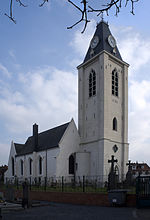Saint-Pierre-en-Antioche Church, Ascq
19th-century Roman Catholic church buildings in FranceBuildings and structures in Villeneuve-d'AscqChurches completed in 1842Churches in Nord (French department)French church stubs ... and 3 more
Infobox religious building with unknown affiliationRoman Catholic church stubsRoman Catholic churches completed in 1932

Saint-Pierre-en-Antioche Church is a Catholic church located in the village of Ascq, now part of the commune of Villeneuve-d'Ascq, Nord department, northern France. The church contains a tapestry designated as a monument historique in 1906, called Les Noces de Cana (Marriage at Cana), painted by A. Werniers in 1735. It was originally part of a collection of six pieces for Saint Sauveur church.
Excerpt from the Wikipedia article Saint-Pierre-en-Antioche Church, Ascq (License: CC BY-SA 3.0, Authors, Images).Saint-Pierre-en-Antioche Church, Ascq
Place du Général de Gaulle, Lille
Geographical coordinates (GPS) Address Nearby Places Show on map
Geographical coordinates (GPS)
| Latitude | Longitude |
|---|---|
| N 50.619444444444 ° | E 3.1594444444444 ° |
Address
Place du Général de Gaulle
Place du Général de Gaulle
59491 Lille, Saint-Sauveur
Hauts-de-France, France
Open on Google Maps








